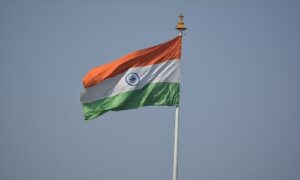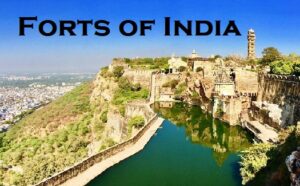Have you ever wondered why the Brahmaputra River’s waters become bright red from June to July?
According to popular belief, the goddess Kamakhya goes through the biological process of menstruation during the month of Ashad, which causes the water of the Brahmaputra to turn red.
The woman who bleeds or menstruation Goddess is another name for the goddess Kamakhya.
This ceremony of the Goddess menstruation is carried out to honour women’s strength, fertility, and capacity for giving birth.
There is no idol dedicated to the goddess Kamakhya.
She is revered as the yoni, the feminine vagina or vulva.

In addition to being intelligent, brave, and the creator, Goddess is also keenly aware of her sexuality, fertility, and other related body functions.
Literally translated, the name Kamakhya means “She whose title/definition is Sexual Desire.” And also denotes that she is simultaneously sought, desired, and the giver of wants.
She is referred to be the provider of salvation, the youthful wife of Shiva, and the yielder of all desires in the ancient Sanskrit literature known as the Kalika Purana.
Like many Hindu deities, Devi is pictured with numerous heads and arms. She is claimed to exist in a variety of forms, though.
Typically, Kamakhya is shown as a young woman dressed in a bright red sari, with six heads of various colours and twelve arms.

Alongside representations of Kamakhya, it’s also usual to see pictures of Siva and a lion.
The temple’s garbagraha is located in a natural cave with a spring.
A gloomy, enigmatic cavern can be found at the bottom of a flight of stairs in the earth’s core.
The “mantra yoni” is kept here, wrapped in flowers and draped in a silk sari.
Kamakhya Temple
The Kamrup-Kamakhya Temple is located atop Nilachal Hill in the Assamese city of Guwahati.
The temple’s architecture is exquisite, and it is one of the most well-liked tourist destinations in North East India, drawing worshippers and pilgrims from all across the nation.
The Temple was constructed between the eighth and seventeenth centuries, destroyed by invaders, and rebuilt numerous times.
This construction and reconstruction have produced a hybrid native architectural style.
The traditional Nagara or North Indian and the Saracenic or Mughal architectural traditions are combined in this distinctive form, which is known as the Nilachal form of Architecture.
In the Temple, this Kamakhya Devi is sitting.
Among the 51 Saktipithas in the nation, this temple is one of the principal pithas (sacred places).
The innermost cave of the main temple, where the deity resides, is described in the Kalika Purana, a significant Hindu literature.
A extremely beautiful pudendum on a stone measuring 12 angulas (9 cm) in width and 20 angulas (16 cm) in length that is gradually narrowing and sloping exists inside the cave.
It has a reddish hue similar to saffron and vermillion.
The seductive Goddess Kamakhya rested on that female organ.
There are various manifestations of the fundamental force.
The temple also contains statues of the ten distinct incarnations of Kali, the goddess of creation, preservation, and destruction.
These include statues of Tripura Sundari, Dhumavati, Matangi, Bagola, Tara, Kamala, Bhairavi, and Chinnamasta.
History of Kamakhya Devi Temple
This Temple, one of the four main Shakti Peetha in the nation, has a long history that dates back to when Lord Shiva and Lord Vishnu were on earth.
According to tradition, Sati marries Lord Shiva against her father Daksha’s objections.
When he performs an Ashwamedha Yajna (great horse sacrifice), a disgruntled Daksha forgets to invite his son-in-law.
Sati chooses to attend the yagna despite not being invited and overhears her father verbally assaulting her spouse.
Sati commits suicide, hoping to be reborn to a more deserving parent since she is disgusted with her father and convinced of her husband’s undeniable excellence.
Lord Shiva is furious at her suicide, therefore, he started the Tandava dance while carrying his deceased wife’s corpse on his shoulder.
The ruin of the entire earth was imminent.
People begged Lord Vishnu to intervene and save them.
Lord Vishnu cut the body of Sati into 51 pieces with his Sudarshana Chakra to safeguard the world.
These severed body parts fell at 51 various locations, which are known as shakti pithas, or holy places.
Because Sati’s womb dropped near the Kamakhya temple, this area became the site of Yoni worship.
According to a Kali Purana narrative, Lord Shiva and Sati experience the delight of male-female union in the Temple, which is said to be the centre of love and romance.
This is where their lovemaking takes place, and Kamakhya is the youthful wife of Lord Shiva.
In Guwahati, there is a myth that Kamdeva, also known as the Lord of romance, was once cursed by Lord Shiva and lost his virility as a result of the curse.

He went in search of the Yoni or Vagina of the Goddess Kamakhya, made sacrifices, and was absolved of his curse.
As a result, Kamapur is another name for this temple.
India’s first AI University will open in Maharashtra
Philips Multi Grooming Kit MG3710/65, 9-in-1 (New Model), Face, Head and Body – All-in-one Trimmer. Self Sharpening Stainless Steel Blades, No Oil Needed, 60 Mins Run Time Brand: PHILIPS
References :
Images: Google images
Temple Website. (2018, July 31).http://www.kamakhyadevi.org/kamakhya-temple/
C. (n.d.). Maa Kamakhya Devalaya. https://www.maakamakhya.org/
कामाख्या देवी मंदिर और गुवाहाटी घूमने की जगह की सम्पूर्ण जानकारी – Bharat Yatri. (2023, June 12). Bharat Yatri. https://www.bharatyatri.com/kamakhya-temple-in-hindi/











